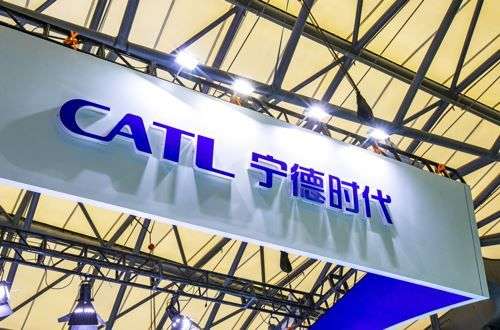Biden Says 50% Of New Cars In The United States Will Have Zero Emissions In 2030: Can The Three Detroit Giants Catch Up With Tesla?
The future of the U.S. auto industry is about to usher in new changes.
On August 5, President Biden signed an executive order at the White House: by 2030, 50% of all new car sales in the United States should achieve zero emissions. When the executive order was signed, executives from general motors, Ford and Chrysler, Detroit's three largest auto makers, stood behind Biden.
Although Biden's goal is not legally binding, the new deal is bound to bring a series of incentives that automakers hope to reap development dividends. General motors, Ford Motor and stellantis group supported the executive order in a joint statement and hope to achieve 40% - 50% of annual sales of electric vehicles in the United States by 2030.
Previously, the electric vehicle industry in the United States was dominated by Tesla, a "upstart in California", whose sales volume was in the lead in North America and the world. In the capital market, Tesla is the leader, with a market value of nearly $700 billion, which is about 9 GM and 12 Ford.
From a global perspective, the trend of electric transformation is unstoppable. In Europe and China, the government strongly supports the development of new energy vehicle industry, and many automobile enterprises also respond positively. Detroit's big three are making slow progress in electric vehicles, both in the United States and elsewhere in the world.
From the joint statement issued by the Detroit Three, on the one hand, they support the new deal, but on the other hand, they are calling on the Biden administration to provide more incentives to catch up with other competitors.
Keep up with China and Europe
Cui Dongshu, Deputy Secretary General of the all China ride Association, said that the 50% target set by the United States is basically in line with the progress of China and Europe.
In July this year, the European Commission proposed that starting from 2035, new vehicles should be required to achieve zero emission, that is, from 2035, the sale of fuel vehicles in the EU will be banned, which is significantly ahead of the previous planning time of 2050. In addition, by 2030, car carbon dioxide emissions will be reduced by 55% compared with 2021.
In China, in 2020, under the guidance of the Ministry of industry and information technology and led by the China Society of automotive engineering, the "energy saving and new energy vehicle technology roadmap 2.0" proposed that by 2035, new energy vehicles will become the mainstream, accounting for more than 50% of the sales. At the same time, the implementation of "double carbon" strategy will greatly promote the development of new energy vehicles in China.
According to the data, in 2020, China's new energy vehicles will account for about 5% of new vehicle sales, and this proportion will rise to 10% in the first six months of this year. In Germany, due to the high purchase subsidies for new energy vehicles in the past two years, the proportion of sales of new energy vehicles has increased from 3% in 2019 to 14% in 2020, and this proportion is still increasing. In 2020, the proportion of new energy vehicles in new car sales in the United States is only 2%.
Obviously, it is very difficult to achieve the 50% target set by the Biden administration. This requires more positive incentives to spend real money.
In fact, Biden has repeatedly expressed his support for the development of the electric vehicle industry in the United States after taking office as president of the United States.
As early as March 31, this year, the Biden government announced a $174 billion electric vehicle industry development support program, including $100 billion of consumer car purchase discounts, 15 billion US dollars of charging pile construction, 45 billion dollars of school bus and bus electrification program, and subsidies for new battery factories in the United States, And provide subsidies for the transformation of closed automobile factories into electric vehicle and parts factories.
The proposal of the specific goal of the development of electrification has pushed the electric transformation of American automobile industry to a new strategic height.
"President Biden believes it's time for the United States to lead in electric vehicle manufacturing, infrastructure and innovation," the White House said in a press release
Revitalizing the U.S. manufacturing sector and providing more jobs are, in fact, an important support for Biden's build back better program.
Therefore, in addition to the big three in Detroit, the United Auto Workers Union (UAW) has issued a statement to support this policy.
"We're not only going to keep union jobs, but we're going to have to increase those jobs and expand the U.S. electric car manufacturing industry from parts to assembly. These future jobs will be high paying and welfare jobs for U.S. unions, not only to support our wages, but also to safeguard key health and safety standards. " UAW means.
Difficult transformation of the three giants
Although the U.S. has Tesla, the world's top selling electric car company, the Detroit giants need to catch up if they want to rebuild the glory of American automobile manufacturing industry.
According to US media data, in 2020, GM, Ford and Tesla will occupy 27%, 14% and 2% of the U.S. auto market, respectively. However, Tesla's share of the U.S. electric vehicle market is as high as 79%. Among the top five models, Tesla's four models are all on the list.
Although the three Detroit giants have already announced their electric transformation strategy, at this stage, several traditional car companies have not yet launched competitive products in the market. At present, the main electric products of GM and Ford are Chevrolet bolt and Ford Mustang mach-e.
However, they are well aware of the need for an electric transformation.
Ford plans to invest $30 billion in global electrification by 2025. According to the plan, Ford will develop two exclusive manufacturing platforms for electric vehicles, one for the development and manufacture of full-size trucks and SUVs, and the other for cars and small SUVs. Based on this, Ford also put forward a rather radical sales target: by 2030, the sales of Ford's pure electric vehicles will account for 40% of its global sales; In the European market, its product lineup will be entirely composed of pure electric vehicles.
In June this year, GM announced that it would increase its investment in electric vehicles and autonomous driving, increasing its investment from $27 billion to $35 billion between 2020 and 2025. By the end of 2025, GM will launch 30 pure electric vehicles around the world, achieving the goal of annual sales of electric vehicles exceeding 1 million. GM also plans to produce only electric vehicles after 2035, achieving zero emissions for all new cars.
Stellantis has previously said it plans to invest at least 30 billion euros in the electric vehicle segment by 2025. According to the company's vision, 98% of the models in Europe and North America will be electrified by 2025.
After the announcement of the new deal, the three giants expressed their support in the joint statement for the first time, claiming that this is a huge change in the U.S. automobile market. However, they also stressed in the statement that this transformation can be achieved only if a series of incentives promised by the government are implemented in a timely manner.
"We look forward to working with the Biden administration to develop policies in Congress, state and local governments to achieve this ambitious goal." It was mentioned in the joint statement.
In the United States, Detroit's established car companies are struggling to catch up with Tesla. Tesla has launched several competitive models, and they are still on the way to build pure electric vehicle production lines; Tesla's direct sales model in the United States has been very perfect, and they are still studying how to let consumers choose electric vehicles; The gap in the charging infrastructure network is even greater. There are less than 100000 electric vehicle charging stations in the United States, while Tesla's official website shows that its number of super charging stations in the United States has reached 25000.
For Ford, GM and other enterprises, if the U.S. policy can drive the growth of scale, thus promoting the progress of their electric vehicle technology, it is also very important for the global development of automobile enterprises.
In China, although the Ford Mustang mach-e model has entered the market, the response is flat. In addition, Ford has not announced other plans for electric vehicles in China. SAIC GM's first intelligent pure electric SUV, Cadillac lyriq, is planned to be launched in the Chinese market in the first half of next year. By 2025, more than 10 domestic new energy vehicles based on the ultium platform will be launched in succession.
At present, the electric vehicle market is still in its infancy, although the latecomers still have the opportunity to catch up, which of course can not do without the promotion of the government. But more importantly, the transformation of traditional automobile enterprises must be more resolute, and the market will give the answer.
?
- Related reading

80 Days After Galanz Acquired Whirlpool China: How To Divide The Four Brands?
|- market research | Will Waste Plastics Be The Best Raw Material For Textiles In The Future?
- Recommended topics | On The Sustainable Development Of Li Ning And Anta
- Recommended topics | Forever 21, A Fast Fashion Brand That Once Lost The Chinese Market, Is Trying To Make A Comeback
- market research | The Surging Trend Of National Style Has Become The Trend Of Post-95 And Post-00
- Listed company | GCL Energy Technology (002015): Application For Non-Public Offering Of Shares Accepted
- Listed company | Beiqing Huanneng (000803): The Controlling Shareholder Pledged 16.8224 Million Shares
- Industry stock market | Shanghai Sanmao (600689): A Pre Profit Of 6.8 Million Yuan In The First Half Of The Year
- Listed company | Xinhua Brocade (600735): Feedback
- Market trend | Upstream And Downstream Good Cotton Yarn Market Strong
- Leadership Forum | Sun Ruizhe: Seeking Truth, Practicing Conscientiously, Taking Advantage Of The Situation And Striving To Promote The High Quality Development Of Industry Service
- In July, China'S Textile And Clothing Exports Fell By 9.65% Year On Year
- In The First Half Of 2021, China Exported 34.174 Billion US Dollars Of Knitted Apparel
- Donghua Teachers And Students Have Been Spinning This Road For Ten Years
- National Bureau Of Statistics: In July 2021, The Ex Factory Prices Of Industrial Producers Rose By 9.0% Year On Year And 0.5% On A Month On Month Basis
- National Bureau Of Statistics
- High Tech Seed Cotton Purchase Price Forecast Higher
- UNIQLO'S "China Dilemma" And "Lie Win" Era Has Passed
- A Survey Of China'S Foreign Trade In Textiles And Clothing In The First Half Of The Year
- From January To July, China'S Textile And Clothing Exports Totaled 1090.21 Billion Yuan
- In The First Half Of The Year, Jiujiang Textile And Garment Industry Occupied Half Of The Province'S Total



